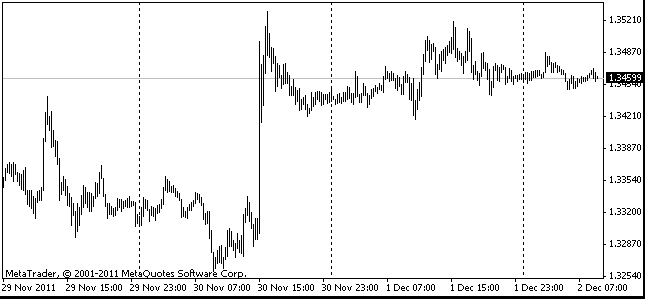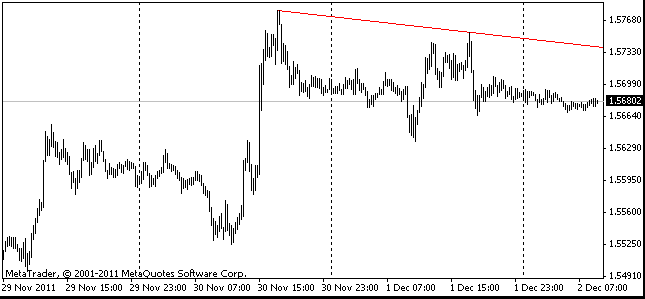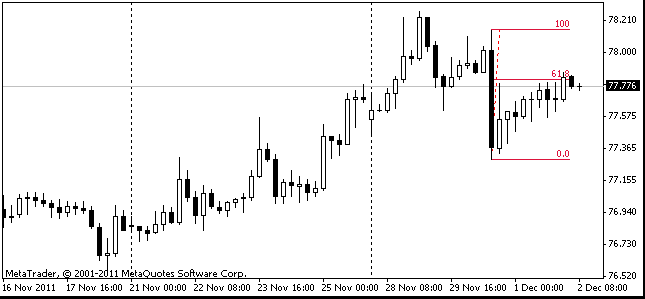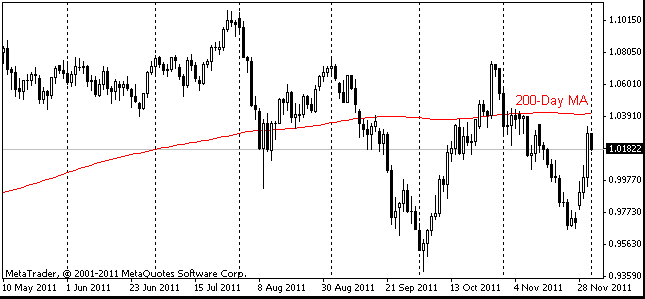EUR/usd
The wave of the euro sales hasn't taken long to appear. Already yesterday the single currency dipped close to 1.30 and stopped only 8 points above that level. Once again the movement was caused not by statistical data, but by politicians' pledges. Throughout the day it became clear that there were certain difficulties in fulfilling those minimum requirements that had been proposed at the summit. The countries were again acting as sovereign states, defending their own interests. The ECB's representative reminded that the Bank was unable to pursue the same policy as the Fed and couldn't be a lender of last resort under the current mandate. Everyone was aware of that and everyone hoped for a miracle. But life is in full swing not only in Europe. For example, yesterday the fomc passed a decision on the rate. The Fed kept pursuing its current policy, apparently being satisfied with the recent signs of the economy normalization. However, there was one dissident, Evans, who voted for increasing stimulus spending. Just in September there were two dissidents who refused to vote for additional stimulus. The situation is changing. In our opinion, the euro will continue its decline in coming days. eurusd is still above the-start-of-the-year lows (1.2875), though it is clear that the situation in Euro-Zone has significantly deteriorated, while in the U.S. it is not that bad.

GBP/USD
sterling was also sold out yesterday, but generally it is in a better situation than its continental vis-a-vis. The pound is at 1.5470, which is still above the levels of late November (1.5420) and much higher than the levels during the sale of early October (1.5270). The stability of the pound is easily explained by strong demand for debt securities of that country. Now they are being purchased not only by investors pulling their money back from the troubled European countries, but by the BOE itself. The impact the latter exerts on the market is considerable: it places between a third and a half of all issued securities onto its balance. And this is just at the time when 10yr gilts yield is near its historic lows, with the 4.8% inflation rate approaching its highest levels over decades. Amazing times! The theory that yields are in correlation with an expected inflation rate, in its turn basing on current CPI rates, is forgotten. The Bank of England has been restraining expectations for two years, promising a sharp decline in CPI. However, the period at which this slowdown was to take place has been constantly carried forward. And even now the rate of price growth is not reducing as fast as predicted by the Bank. If the prices of energy and raw materials didn't slump in the coming months (which rarely happens in this time of the year), inflation could again prove to be stronger than expected, and investors once again would suffer losses on the negative yield of their investments.

USD/JPY
Despite the sales in the markets the yen is obediently falling against the dollar now. Previously the decline of stock markets has been provoked by stronger demand for the yen than for the dollar. This time the victorious march of the greenback though not so vigorously, but goes to the yen, too. The pair is trading close to 78.0. On the four-hour candlestick chart it is clearly displayed how the pair has been bought on dips. usdjpy is persistently getting to the resistance line of the long-term downward trend. Of course, we've witnessed this a plenty of times from 2007. But it is noteworthy that it will be the second testing of this level over the last six weeks. Before it happened only once a year or even once in a year and a half. Something has changed in the markets. Fundamentally, this change is connected with the fact that the dollar is becoming the funding currency, as its interest rates are almost zero, just like in Japan, and as the Fed assures they will remain so at least until the middle of 2013.

AUD/USD
It hasn't taken much time to go to the parity. Yesterday and this morning AUD fell to 0.9980, and both times it then bounced up to the level of a bit higher than 1.00. Speaking about the fact that the markets are trying to reach round figures by the end of the year, aussie has already attained its primary goal – the parity. It is now unlikely that bulls or bears will be able to win it over to their side. By the way, despite its enormous volatility throughout the year Aussie is now displaying the near-zero momentum. However, the same can be said about other major currencies against the dollar: the pound, the euro, the Swiss franc. The year is ending with zero results for strategic investors. And there is a sneaking suspicion that the coming year could become the year of the dollar on the slowdown of Asian economies.
